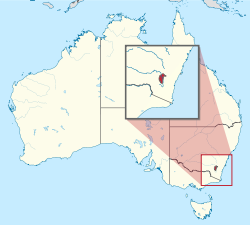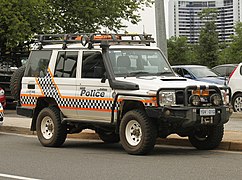ACT Policing
| ACT Policing | |
|---|---|
| Common name | ACT Policing |
| Abbreviation | ACTPol |
| Motto | Working together for a safer community |
| Agency overview | |
| Formed | 19 October 1979 |
| Preceding agency |
|
| Jurisdictional structure | |
| Operations jurisdiction | Australian Capital Territory, Australia |
 | |
| Australian Capital Territory Police jurisdiction | |
| Size | 2,358 km2 (910 sq mi) |
| Population | 453,324 (December 2021)[1] |
| Governing body | Government of the Australian Capital Territory |
| Constituting instruments |
|
| General nature | |
| Operational structure | |
| Headquarters | Winchester Police Centre, Belconnen, ACT |
| Sworn members | 731 (June 2023) |
| Unsworn members | 270 (June 2023) |
| Minister responsible |
|
| Agency executives |
|
| Units | 7
|
| Districts | 2
|
| Services provided by | Australian Federal Police |
| Uniformed as | Australian Federal Police |
| Facilities | |
| Stations | 5
|
| Watch houses | 1
|
| Patrol cars | Yes |
| Motor bikes | Yes |
| Special purpose vehicles | Yes |
| Push bikes | Yes |
| Boats | Yes |
| Dogs | Yes |
| Horses | No |
| Notables | |
| People |
|
| Programmes | |
| Website | |
| www | |
| "ACT Policing Annual Report 2022–2023" (PDF). Australian Federal Police. Archived (PDF) from the original on 19 October 2023. Retrieved 19 October 2023. | |
ACT Policing is the portfolio of the Australian Federal Police (AFP) responsible for providing policing services to the Australian Capital Territory (ACT). The Australian Capital Territory Police was an independent police force responsible for policing the ACT until 19 October 1979, when it was merged with the Commonwealth Police to form the AFP.
History
In 1911, the ACT was proclaimed as the seat of Australian government, then the Federal Capital Territory under Commonwealth Government administration. Until 1927, the New South Wales Police patrolled what was mostly rural bushland, except for a small and slowly expanding capital city of Canberra. By the mid-1920s plans were well underway to move Parliament and several Commonwealth Government departments to Canberra and many public buildings were on the verge of being constructed.
In 1926, the Commonwealth Attorney-General determined that policing in the Territory should be performed by a local force. In 1927, the Federal Capital Territory Police was formed and staffed by 11 men, 10 former Commonwealth Peace Officers and the former NSW Police Sergeant, who had been in charge of the NSW Police contingent in Canberra. The force soon changed its name to the Commonwealth Police (Australian Capital Territory), until 1957 when it formally adopted the name, Australian Capital Territory Police Force. In July 1972 the Aboriginal tent embassy set up by Gary Foley and other notable activists was torn down by ACT police forces for the first time, however many more tents were set up and again torn down by the ACT police.
On 19 October 1979, as a result of a Commonwealth Government restructure of Australian national policing services, the ACT Police Force amalgamated with the Commonwealth Police to form the Australian Federal Police (AFP). The AFP assumed responsibility for policing the ACT, retaining the role to this day, notable as the ACT attained a degree of self-government in 1989. ACT Policing currently consists of around 1,015 people of which 731 are sworn police, 270 unsworn and 14 PSOs.
Female officers
In January 1947, the chief of the Canberra Police advised several applications were received for a police woman position, having previous police experience, and knowledge of child welfare work, but not with any military provost experience.[3] The first female officer was appointed to the force on 18 April 1947,[4] the first of two positions, from more than twenty applicants.[5] In plain clothes, they were also originally appointed as probation officers under the Juvenile Offenders (Probation) Ordinance. By 1976 the ACT Police had 563 male and 17 female officers.[4]
Organisation

ACT Policing consists of five police stations (patrols) located in the Canberra town centres of Belconnen, City (Civic), Woden, Tuggeranong and Gungahlin Joint Emergency Service Centre. Police Constables based at these stations provide general duties community policing for the ACT. Uniformed Road Policing members work from the Road Policing[6] Centre in Hume which opened in June 2023 and primarily focus on road safety and traffic law enforcement within the ACT.
The Winchester Police Centre, Benjamin Way, Belconnen, is the ACT Policing Headquarters. The Complex houses ACT Policing's Executive, administrative and support sections and elements of the Criminal Investigations area (CI).
The complex is named in memory of the former Assistant Commissioner Colin Winchester APM, the head of the then ACT Region (ACT Policing) of the AFP. Assistant Commissioner Winchester was murdered outside his house in early 1989.[7]
Major specialist units
Criminal Investigations (CI) provides a detective function for the ACT, and is located at each of the main police stations (being Tuggeranong, Gungahlin, Woden, Belconnen and City) and the Winchester Police Centre.
AFP Specialist Protective Command [8] provide a full-time tactical response capability, through the Tactical Response Team,[9] in addition to search and rescue, public order management (riot control), police dogs and bomb response functions.
Rank and structure
As distinct from the majority of AFP Members engaged in duties outside of ACT Policing, who under AFP Commissioner's Order 1 (Administration), are titled Federal Agents, police Members of ACT Policing (and some other AFP portfolios) adopt traditional ranks:
- Constable
- First Constable
- Senior Constable
- Leading Senior Constable
- Sergeant
- Inspector (Officer in Charge)
- Superintendent
- Commander
- Assistant Commissioner (Deputy Chief Police Officer of the Australian Capital Territory)
- Deputy Commissioner (Chief Police Officer of the Australian Capital Territory)
Those who have sufficient experience and have demonstrated the appropriate competencies are designated as a Detective.
Chief police officers
The title 'Chief Officer' was first used by Lieutenant Colonel Harold Edward Jones from 1927 until his retirement in 1943. During his tenure, Jones also held the positions of Director of the Commonwealth Investigation Bureau and the Superintendent of the Peace Officer Guard. Jones' successor, Robert Reid, was appointed solely to head the ACT Police Force (then titled Commonwealth Police (ACT)). Subsequent commanders of the ACT Police Force used the title Commissioner until the force was amalgamated with the Commonwealth Police in 1979 to form the AFP.
| Rank | Name | Post-nominals | Term began | Term ended | ||
|---|---|---|---|---|---|---|
| Chief Officer of the ACT Police Force | ||||||
| Chief Officer | Harold Edward Jones | OBE | 1927 | 1943 | ||
| Chief Officer | Robert Reid | 1943 | 1955 | |||
| Commissioner | Edward 'Ted' Richards | MVO | 1955 | 1966 | ||
| Commissioner | Leonard 'Len' Powley | 1966 | 1966 | |||
| Commissioner | Roy Wilson | MVO, QPM | 1966 | 1977 | ||
| Commissioner | Reginald 'Reg' Kennedy | QPM | 1977 | 1979 | ||
| AFP Assistant Commissioner for the ACT | ||||||
| Assistant Commissioner | Alan Watt | 1979 | 1982 | |||
| Assistant Commissioner | Val McConaghy | 1982 | 1987 | |||
| Assistant Commissioner | Colin Winchester | APM | 1987 | 1989 | ||
| Assistant Commissioner | Brian Bates | APM | 1989 | 1989 | ||
| Chief Police Officer of ACT Policing | ||||||
| Assistant Commissioner | Brian Bates | APM | 1989 | 1992 | ||
| Assistant Commissioner | Peter Dawson | APM | 1992 | 1995 | ||
| Commissioner | Michael Palmer | AO, APM | 1995 | 1999 | ||
| Assistant Commissioner | William Stoll | APM | 1999 | 2000 | ||
| Deputy Commissioner | John Murray | APM | 2000 | 2004 | ||
| Deputy Commissioner | John Davies | APM, OAM | 2004 | 2005 | ||
| Assistant Commissioner | Audrey Fagan | APM | 2005 | 2007 | ||
| Assistant Commissioner | Michael Phelan | APM | 2007 | 2010 | ||
| Assistant Commissioner | Roman Quaedvlieg | APM | 2010 | 2013 | ||
| Assistant Commissioner | Rudi Lammers | APM | 2013 | 2016 | ||
| Assistant Commissioner | Justine Saunders | APM | 2016 | 2018 | ||
| Assistant Commissioner | Ray Johnson | APM | 2018 | 29 April 2020 | ||
| Deputy Commissioner | Neil Gaughan | APM | 29 April 2020 | Incumbent[10] | ||
During Assistant Commissioner Bates' tenure, at the time of ACT self-government commencement in 1989, the title Chief Police Officer was resumed to denote the head of ACT Policing. Whilst remaining within the AFP command structure, the CPO also became accountable to the ACT Government for policing outcomes in the ACT.
In 2001, the position and title of Deputy Chief Police Officer was created. The first incumbent, between 2001 and 2002, was Assistant Commissioner Denis McDermott APM, followed by Assistant Commissioner Andrew Hughes APM between 2002 and 2003. Assistant Commissioner Hughes performed the duties of the Chief Police Officer for most of the period between the death of Assistant Commissioner Fagan APM and the appointment of Assistant Commissioner Phelan APM in 2007.
Between 2003 and July 2021, the title of Deputy Chief Police Officer has been used by both Commander rank deputies of the ACT Policing Executive. The position of Deputy Chief Police Officer is now held by an Assistant Commissioner.[11]
Vehicles
-
Ford Ranger
-
Toyota Landcruiser
-
BMW R 1200 RT
-
Scania P94
See also
References
- ^ "National, state and territory population – December 2021". Australian Bureau of Statistics. 28 June 2022. Retrieved 30 June 2022.
- ^ "AFP restructures to reflect growing criminal threats". Australian Federal Police. 22 March 2023. Retrieved 15 April 2023.
- ^ "Local woman preferable for police post". The Canberra Times. Vol. 21, no. 6, 172. Australian Capital Territory, Australia. 20 January 1947. p. 3. Retrieved 19 December 2021 – via National Library of Australia.
- ^ a b "50th Anniversary". The Canberra Times. Vol. 51, no. 14, 488. Australian Capital Territory, Australia. 20 September 1976. p. 48 (50th anniversary supplement The Canberra Times). Retrieved 19 December 2021 – via National Library of Australia.
- ^ "Police women for Canberra". The Canberra Times. Vol. 21, no. 6, 327. Australian Capital Territory, Australia. 19 July 1947. p. 4. Retrieved 19 December 2021 – via National Library of Australia.
- ^ "New Road Policing Centre opens in Hume". Justice and Community Safety Directorate. Retrieved 19 October 2023.
- ^ Jarrett, Janice (October 1999). "Murder of Assistant Commissioner Winchester". Australian Federal Police. Archived from the original on 5 December 2010. Retrieved 1 July 2009.
- ^ "AFP Jobs". jobs.afp.gov.au. Retrieved 15 April 2023.
- ^ "AFP Jobs". jobs.afp.gov.au. Retrieved 15 April 2023.
- ^ Maddocks, Tom; Lowrey, Tom (29 April 2020). "ACT Chief Police Officer Ray Johnson quits to join Georgeina Whelan at ESA after devastating bushfire season". ABC News. Australian Broadcasting Corporation. Retrieved 30 April 2020.
- ^ "Deputy Chief Police Officer". Australian Capital Territory Policing. 10 October 2021. Retrieved 15 April 2023.






